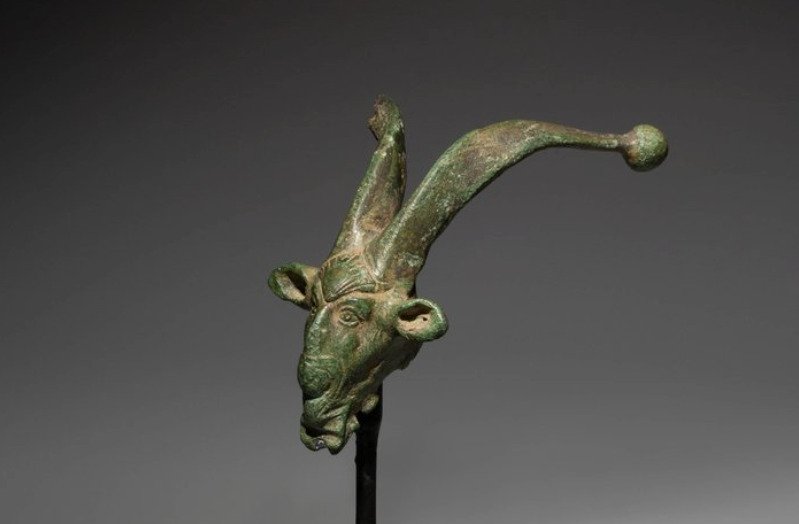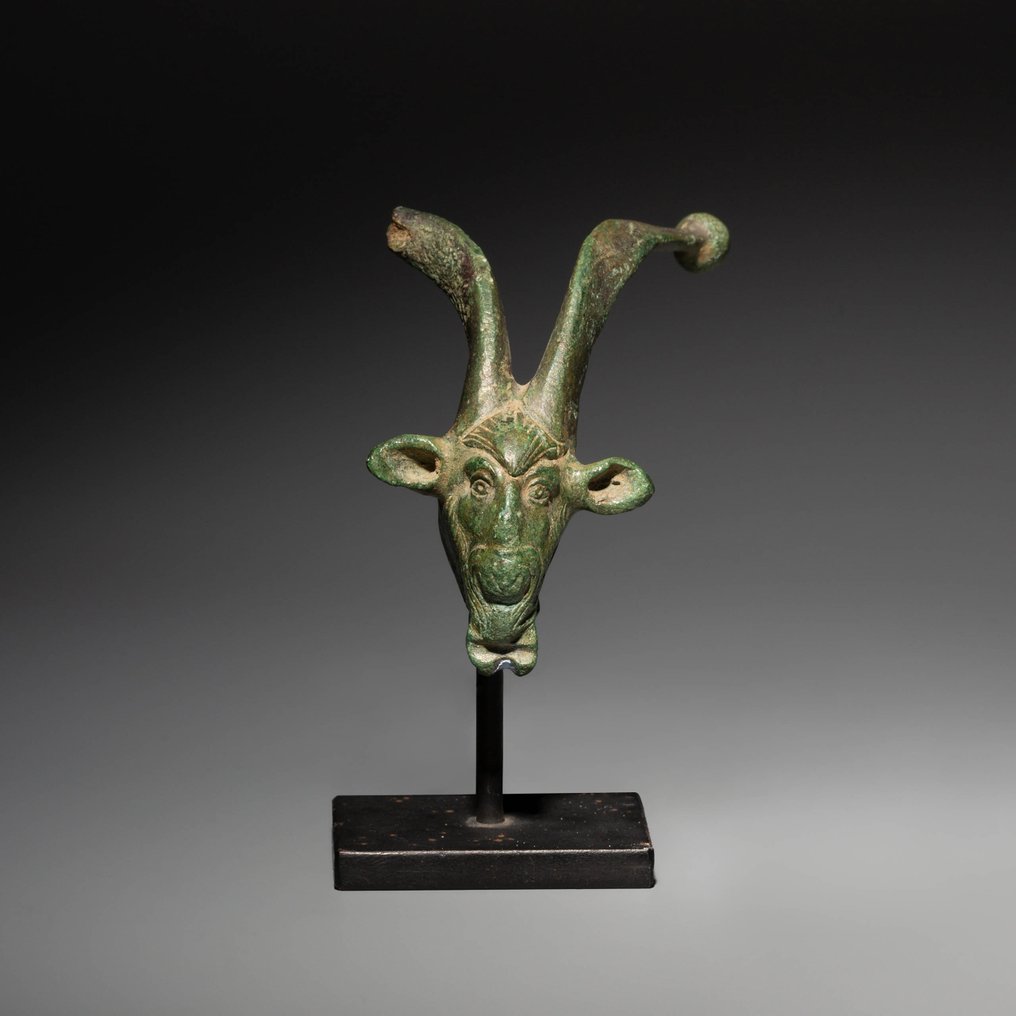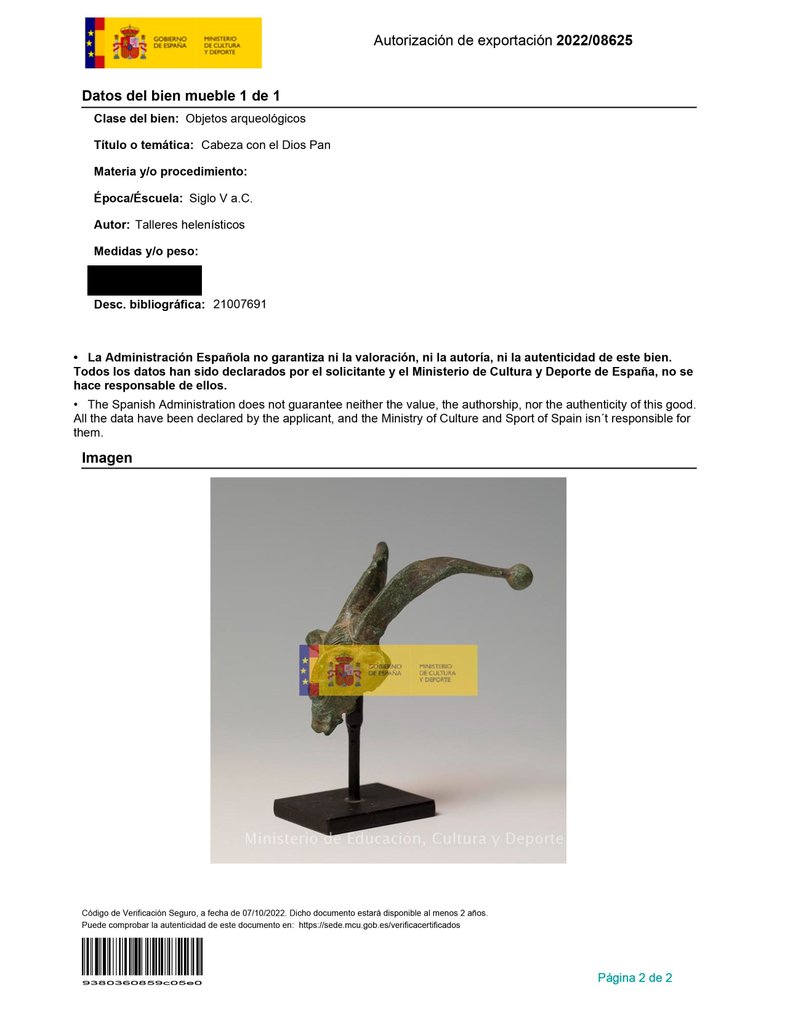Magnífica la entrega y el objeto. Perfecta la sonido del sibato
Se oversættelseOldtidens Grækenland Bronze Flot hoved af guden Pan. Hellenisme. 5. århundrede f.Kr. 9,5 cm H.
Nr. 88173963






Head of the god Pan.
- nice quality -
Ancient Greece, Helenistic period, 5th century BC.
Bronze.
9.5 cm height without stand.
Condition: Good condition. A horn is missing.
Provenance: Private collection, A.A., Brussels. Acquired from Naxos Art Limited, London in 1996. A copy of the bill of sale is attached.
Private collection, Estepona, Malaga.
Wall light made of lost wax bronze, half-bulk, representing the head of the god Pan. It would originally be an ornament added to a larger object, such as a glass, a piece of furniture or a carriage. Pan is represented in his most animalistic aspect, with a caprine head with large horns ending in balls, large ears and a flat nose, elongated like a snout. The modeling is careful and naturalistic, and is complemented by cold chiselling work for details such as the texture of the fur.
Personification of lust, wild god of fertility, protector of herds and symbol of sexual potency, Pan was considered to come from Arcadia and the son of Hermes and a nymph from that region. Fearsome deity, he was sometimes capable of causing the so-called "panic terror", so his help was often invoked in battles to frighten the enemy. He was described as an animal-looking being, with goat's horns and shaggy hair and beard, although he was appreciated by the gods due to the beauty of the music he played on his reed flute, the syrinx or Pan's flute. In older representations of a certain complexity, found in Athens from the 6th century BC, it is depicted with the head of a goat, an erect phallus and the feet or legs of a goat. He will soon be related to the Dionysian cult, and from the Late Classicism, he will join the procession of Dionysus. With the passage of time he will acquire a more human and even pleasant appearance, although most of the representations of Pan will retain the animal face with a flattened, aquiline nose, pointed ears and a large, meaty mouth.
The Homeric Hymn to Pan related the god to the concept of totality, due to his name (pan means “all” in Greek), an idea that Boccaccio took up again in the 14th century. Hand in hand with him, humanists will use the figure of this god, both for his name and for his hybrid nature, as a symbol of universal Nature in its original state of chaos, developing the idea of the so-called Cosmic Pan. Alciato will later interpret Pan as a synonym for Nature, considering the lower part of his body a representation of the union with the animal world and the upper part of the relationship with divinity.
Lost wax casting is a very difficult procedure for making metal pieces, which requires careful planning and coordination between the sculptor, the molder and the caster. The first step consists in the elaboration of the prototype of the object in wax, perfectly finished in all its details, including the polishing. Channels, vents and an inlet cone are added to this model and lined with refractory clay. Once the clay dries, heat is applied and the wax melts, evacuating the ceramic container that has taken its negative shape through the channels. Thus, a mold is obtained that is filled with molten metal through the inlet cone, spreading out evenly thanks to the vents. Finally, once the metal has solidified, the ceramic coating is broken to release the finished part. It is, therefore, a technique that only allows the creation of unique pieces.
PARALLELS:
Fig. 1 Wall lamp in the shape of a goat's head. Greece, ss. III-I BC, bronze. Cleveland Museum of Art (USA), inv. 1940.666.
Fig. 2 Jug handle in the shape of the god Pan. Greece, h. 480-450 B.C., bronze. British Museum, London, inv. 1918.0101.22.
Fig. 3 Jug handle in the shape of the god Pan. Greece, h. 480-450 B.C., bronze. British Museum, London, inv. 1918.0101.22.
Notes:
- The piece includes authenticity certificate.
- The piece includes Spanish Export License (Passport for European Union). NOT TAXES.
- According to Spanish legislation, items sent outside the European Union are subject to export taxes and will be added to the invoice, at the buyer's expense. These export fees are fixed on the final auction price and the tax rate is not applied directly on the total value of the item to be exported, but rather the different percentages by sections are applied to it:
- Up to 6,000 euros: 5%.
- From 6.001 to 60.000 euros: 10%.
This export permit application process can take between 1-2 months maximum.
- The seller guarantees that he acquired this piece according to all national and international laws related to the ownership of cultural property. Provenance statement seen by Catawiki.
#ancientcivilisations
Sælger's Historie
Head of the god Pan.
- nice quality -
Ancient Greece, Helenistic period, 5th century BC.
Bronze.
9.5 cm height without stand.
Condition: Good condition. A horn is missing.
Provenance: Private collection, A.A., Brussels. Acquired from Naxos Art Limited, London in 1996. A copy of the bill of sale is attached.
Private collection, Estepona, Malaga.
Wall light made of lost wax bronze, half-bulk, representing the head of the god Pan. It would originally be an ornament added to a larger object, such as a glass, a piece of furniture or a carriage. Pan is represented in his most animalistic aspect, with a caprine head with large horns ending in balls, large ears and a flat nose, elongated like a snout. The modeling is careful and naturalistic, and is complemented by cold chiselling work for details such as the texture of the fur.
Personification of lust, wild god of fertility, protector of herds and symbol of sexual potency, Pan was considered to come from Arcadia and the son of Hermes and a nymph from that region. Fearsome deity, he was sometimes capable of causing the so-called "panic terror", so his help was often invoked in battles to frighten the enemy. He was described as an animal-looking being, with goat's horns and shaggy hair and beard, although he was appreciated by the gods due to the beauty of the music he played on his reed flute, the syrinx or Pan's flute. In older representations of a certain complexity, found in Athens from the 6th century BC, it is depicted with the head of a goat, an erect phallus and the feet or legs of a goat. He will soon be related to the Dionysian cult, and from the Late Classicism, he will join the procession of Dionysus. With the passage of time he will acquire a more human and even pleasant appearance, although most of the representations of Pan will retain the animal face with a flattened, aquiline nose, pointed ears and a large, meaty mouth.
The Homeric Hymn to Pan related the god to the concept of totality, due to his name (pan means “all” in Greek), an idea that Boccaccio took up again in the 14th century. Hand in hand with him, humanists will use the figure of this god, both for his name and for his hybrid nature, as a symbol of universal Nature in its original state of chaos, developing the idea of the so-called Cosmic Pan. Alciato will later interpret Pan as a synonym for Nature, considering the lower part of his body a representation of the union with the animal world and the upper part of the relationship with divinity.
Lost wax casting is a very difficult procedure for making metal pieces, which requires careful planning and coordination between the sculptor, the molder and the caster. The first step consists in the elaboration of the prototype of the object in wax, perfectly finished in all its details, including the polishing. Channels, vents and an inlet cone are added to this model and lined with refractory clay. Once the clay dries, heat is applied and the wax melts, evacuating the ceramic container that has taken its negative shape through the channels. Thus, a mold is obtained that is filled with molten metal through the inlet cone, spreading out evenly thanks to the vents. Finally, once the metal has solidified, the ceramic coating is broken to release the finished part. It is, therefore, a technique that only allows the creation of unique pieces.
PARALLELS:
Fig. 1 Wall lamp in the shape of a goat's head. Greece, ss. III-I BC, bronze. Cleveland Museum of Art (USA), inv. 1940.666.
Fig. 2 Jug handle in the shape of the god Pan. Greece, h. 480-450 B.C., bronze. British Museum, London, inv. 1918.0101.22.
Fig. 3 Jug handle in the shape of the god Pan. Greece, h. 480-450 B.C., bronze. British Museum, London, inv. 1918.0101.22.
Notes:
- The piece includes authenticity certificate.
- The piece includes Spanish Export License (Passport for European Union). NOT TAXES.
- According to Spanish legislation, items sent outside the European Union are subject to export taxes and will be added to the invoice, at the buyer's expense. These export fees are fixed on the final auction price and the tax rate is not applied directly on the total value of the item to be exported, but rather the different percentages by sections are applied to it:
- Up to 6,000 euros: 5%.
- From 6.001 to 60.000 euros: 10%.
This export permit application process can take between 1-2 months maximum.
- The seller guarantees that he acquired this piece according to all national and international laws related to the ownership of cultural property. Provenance statement seen by Catawiki.
#ancientcivilisations
Sælger's Historie
- 823
- 10
- 1
very well packed with all the documents included, thnks
Se oversættelseGreat object. Really beautiful. Quick delivery. Excellent.
Se oversættelseSuperbe objet, Service d'Arqueologia Ancient Art excellent et rapide. Jaume Bagot toujours parfait .
Se oversættelseTodo perfecto gracias
Se oversættelseNice item all ok A+++
Se oversættelseThank you for this Oinochoe, one question: did you as promised read my post!
Se oversættelseVery cooperative in every aspect of the transaction.
Se oversættelseAlways a great pleasure!
Se oversættelseFine quality, good service. Thanks.
Se oversættelseMuy amables, muy bien todo. Gracias
Se oversættelseAlles bestens
Se oversættelseexactly as described and shipped safely and punctually.
Se oversættelseschnelle Lieferung sehr sichere Verpackung alles bestens
Se oversættelsetres bel objet je le recherchai depuis longtemps envoi rapide et protégé je pense qu'il y aura d'autres achats avec ce vendeur merci +++++++
Se oversættelseEinfach nur toll
Se oversættelseTodo perfecto
Se oversættelseottimo
Se oversættelseperfetto
Se oversættelsetop oggetto bellissimo grazie 💯💯💯💯💯💯 :-)
Se oversættelseI bought this beautiful artifact together with artifact from Mr. Bagot but although it is clearly stated on his shipping page that when purchasing multiple artifacts i paid the double package costs
Se oversættelseI bought this beautiful artifact together with artifact from Mr. Bagot but although it is clearly stated on his shipping page that when purchasing multiple artifacts i paid the double package costs
Se oversættelseBel objet, bien emballé. Parfait.
Se oversættelsewonderful faiece and very fast shipping.thanks a lot
Se oversættelseJ Bagot es un profesional excelente. Sus artículos son de gran calidad, se incluye la documentación necesaria y el embalaje se realiza con esmero. Le recomiendo encarecidamente.
Se oversættelse- 823
- 10
- 1
Magnífica la entrega y el objeto. Perfecta la sonido del sibato
Se oversættelseDisclaimer
Sælger garanterer og kan bevise, at genstanden er erhvervet på lovlig vis. Sælger er blevet informeret af Catawiki om, at skulle fremskaffe den dokumentation, der kræves af love og regler i dennes bopælsland. Sælger garanterer at være berettiget til, at måtte sælge/eksportere denne genstand. Sælger sørger for, at al information vedrørende proveniensen af en genstand vil blive videregivet til køber. Sælger sørger for, at eventuelle nødvendige tilladelser er blevet eller vil blive indhentet. Sælger vil omgående informere køber om eventuelle forsinkelser i forbindelse med indhentelse af sådanne tilladelser.
Sælger garanterer og kan bevise, at genstanden er erhvervet på lovlig vis. Sælger er blevet informeret af Catawiki om, at skulle fremskaffe den dokumentation, der kræves af love og regler i dennes bopælsland. Sælger garanterer at være berettiget til, at måtte sælge/eksportere denne genstand. Sælger sørger for, at al information vedrørende proveniensen af en genstand vil blive videregivet til køber. Sælger sørger for, at eventuelle nødvendige tilladelser er blevet eller vil blive indhentet. Sælger vil omgående informere køber om eventuelle forsinkelser i forbindelse med indhentelse af sådanne tilladelser.









